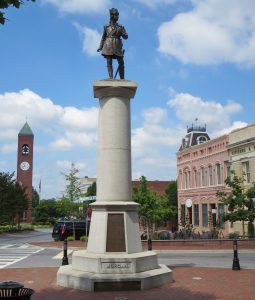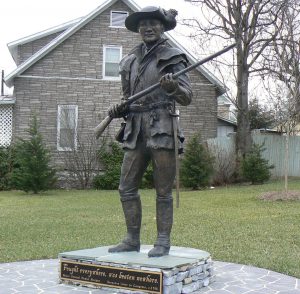On January 17, 1781, at Cowpens, South Carolina, Gen. Daniel Morgan solidified his position as an iconic Revolutionary War figure with his decisive victory over Lt. Col. Banister Tarleton. This victory over the aggressive and capable Tarleton had significant consequences for the war in the southern colonies and contributed to Gen. Charles Cornwallis’s risky decision to pursue and attempt to destroy Gen. Nathaniel Greene’s southern army. Ultimately, Cornwallis’s pursuit of Greene and attempts to pacify the south ended badly for Cornwallis and the British.
Morgan’s health deteriorated during the campaign and when he returned home to Virginia to recover, other Patriot leaders stepped forward to fight for the Rebel cause. Cowpens was Morgan’s final decisive contribution to the Revolution but not to the nation. He continued his service to the young United States during the Whiskey Rebellion and while serving a term in the House of Representatives from his home state, Virginia. He passed away peacefully in 1802 at age sixty-six. His peaceful rest would be disrupted during the twentieth century when the citizens of Cowpens, South Carolina, expressed a renewed interest in Morgan’s Cowpens victory and began a campaign to highlight the importance of the battle. They recognized the significance of Morgan’s Revolutionary War success there and attempted to lay claim to his legacy. The attempt resulted in a dispute between the citizens and elected officials of South Carolina and Virginia; this dispute may appropriately carry the title, the “Second Battle of Cowpens.”
Today, Daniel Morgan’s body lies peacefully in Mount Hebron Cemetery in Winchester, Virginia. Sixty-seven years ago, however, August 5, 1951, on a warm Sunday morning, a feud erupted between Virginia and South Carolina over the hero of Cowpens; Morgan would likely have applauded and approved of the audacity of the South Carolina delegation as a Cowpens undertaker, J. G. Floyd, accompanied by two assistants, arrived at the Mount Hebron Cemetery armed with shovels, prepared to exhume Morgan’s remains and move them to the more honorable and dignified setting of the Cowpens Battlefield.[1] One of Morgan’s surviving descendants, his great-great granddaughter, Mrs. Josephine Neville Strong Callahan, of Redwood City, California, provided the South Carolina delegation a letter authorizing the representatives from Cowpens to exhume Morgan’s body for the purpose of relocation. She believed Cowpens, South Carolina provided a more appropriate resting place for the iconic “Revolutionary Rifleman.”[2]
Winchester fought back. In an effort to efficiently and quickly resolve the struggle, the South Carolinians graciously offered an invitation for the Virginians to attend the dedication of a grand monument to Morgan at Cowpens. The mayor of Winchester, Mifflin B. Clowe, and local lawyer, Thomas Scully, rejected it outright. Scully snapped back, they would have “A dedication without a body.”[3] The Mount Hebron Cemetery Superintendent, upon learning of the South Carolinians attempt to remove Morgan’s remains, exhorted, “General Morgan, sir? You’re not taking General Morgan today, tomorrow, or the next day!” With Virginia and South Carolina in a stand-off, the dispute over Morgan’s remains went to the courts and quickly conflagrated into a political issue as well.[4]
The governor of South Carolina, James F. Byrnes, himself a lawyer, former U.S. Secretary of State and politically powerful U.S. Senator, sided with the South Carolinians. As a counter, the Virginians received the political support of the powerful U.S. Senator Harry F. Byrd, himself a former Virginia Governor. Senator Byrd lived just east of Winchester, as General Morgan had, a point that seemed to strengthen Byrd’s position in defense of Morgan. In fact, they ultimately ended up residing more closely – upon his passing in 1966, Senator Byrd was also interred at Mount Hebron Cemetery.[5]
South Carolina filed a petition with the Winchester Court to uphold their right to remove Morgan’s remains and the two sides’ legal posturing began.[6] Then, the Winchester-Frederick County Historical Society and the Mount Hebron Cemetery Board filed a motion to “Intervene” because they held “Substantial Interest” in the matter.[7] These same groups also filed a “Demurer” indicating South Carolina had no case to argue.[8] The South Carolina “Bill of Complaint” contained thirty-six paragraphs arguing that Virginia did not properly honor and recognize Morgan’s significant revolutionary accomplishments and neglected his grave.[9] Virginia’s response consumed nine legal sized sheets and sustained some of the points but argued against neglect and promoted Morgan’s ties to Virginia and the Winchester area. In the end, somewhat anti-climactically, the legal battle over Morgan’s remains ended on January 7, 1952 when the presiding judge dismissed the case brought by South Carolina.[10] But the sequence of events energized the Winchester community to protect Morgan’s legacy.
The fight over Morgan’s remains received national attention and provided the impetus for the citizens of Winchester to act and provide a more appropriate monument to the “Hero of Cowpens.”[11] In April 1952, only three months after the dismissal of the court case, a consortium of Winchester community organizations including: the Winchester-Frederick County Historical Society, the Fort Loudoun Chapter Daughters of the American Revolution, and the Lions Club, contracted the Rock of Ages Company of Barre, Vermont, for the proposed memorial. The new monument to honor Morgan cost $2,000. The entire Winchester community contributed, and even school children from its seven schools donated over $40.00 to the cause.[12] To this day, the local Winchester community celebrates Morgan’s accomplishments. Relatively recently, in 2005, Winchester dedicated a life-sized bronze monument to Morgan and located it in a prominent position at the Old Stone Presbyterian Church—Morgan’s original resting place. The statue carries the appropriate inscription, “Fought everywhere, was beaten nowhere.”[13] The Fort Loudoun Chapter Daughters of the American Revolution also recognized Morgan with a graveside event in 2017.[14]
Perhaps the first community to recognize Morgan’s actions at Cowpens and appropriately memorialize the general was Spartanburg, the largest South Carolina city located near the Cowpens Battlefield. In 1881, on the centennial of Cowpens, the U.S. Congress, with support of the citizens of Spartanburg, erected a bronze statue to Morgan at a cost of $23,000.[15] Today, the statue sits in Morgan Square, with Morgan facing the battlefield. And in a true sign of enduring glory, the city boasts a Daniel Morgan Avenue.[16] The federal government assumed responsibility for the Cowpens Battlefield in 1933, but support for Morgan was not a new phenomenon. South Carolina’s efforts to memorialize Morgan and his significant Revolutionary accomplishments in helping liberate the state from British colonial rule persist even though he campaigned there for only a few weeks.


The next time you pass near Spartanburg, South Carolina or Winchester, Virginia, stop by Morgan Square, Mount Hebron Cemetery or the Old Presbyterian Church, pay your respects General Daniel Morgan, and take a look at the fine monuments the citizens of Spartanburg and Winchester erected in 1881, 1952 and 2005 respectively.[17] While Cowpens was unsuccessful in claiming Morgan’s remains, the existing monuments serve purposes beyond Morgan alone. The monuments remind us of the power of community action by engaged representatives of multiple communities to act locally, to preserve the history of their communities and regions. They also remind us of the wisdom and passion exhibited by the local and national leaders of the communities involved, who understood and respected the significance of the actions by Morgan and his men on the battlefield that cold day in January 1781. The legacy of both Morgan and those communities challenge us to continually ensure future generations understand why these monuments are important.[18] In the end, all communities and citizens with an interest in recognizing the Revolutionary War accomplishments of Daniel Morgan and the price of freedom are winners of the “Second Battle of Cowpens.”
[1] Elizabeth Gold Crawford Engle and Mary Thomason Morris, “Cannons and Marble: A Monument for Daniel Morgan,” Winchester Frederick County Historical Society Journal, XVI (2002), 125.
[2] “Who Gets the General’s Body? Two Southern towns battle over grave of Daniel Morgan, hero of Cowpens,” Life, 31 (September 3, 1951), 53-59, books.google.com/books?id=k04EAAAAMBAJ&pg=PA53&source=gbs_toc_r&hl=en#v=onepage&q&f=false, accessed December 28, 2017.
[3] Ibid., 54.
[4] Jim Moyer, “Who gets Daniel Morgan’s Body?,” French and Indian War Foundation, January 9, 2016, updated April 22, 2017, frenchandindianwarfoundation.org/event/who-gets-daniel-morgans-body/, accessed December 28, 2017.
[5] Robert K. Woltz, “The Second Battle of Cowpens,” Winchester Frederick County Historical Society Journal, XVI (2002), 135.
[6] Engle and Thomason, “Cannons and Marble,” 126.
[7] Wolz, “The Second Battle of Cowpens,” 135.
[8] Ibid.,136.
[9] Ibid., 133.
[10] Ibid., 137-8.
[11] Moyer references a Chicago Tribune article published on August 7, 1951 that purports national media coverage of the events.
[12] Engle and Thomason, “Cannons and Marble,” 127-8.
[13] The Historical Marker Data Base, Major General Daniel Morgan, June 16, 2016, www.hmdb.org/Marker.asp?Marker=4740 , accessed January 7, 2018.
[14] Josh Janney, “Daniel Morgan grave marker dedicated,” The Winchester Star, July 8, 2017, www.winchesterstar.com/news/winchester/daniel-morgan-grave-marker-dedicated/article_3f13aa74-f6bf-5e80-8e2d-85f08601f957.html#comments, accessed January 7, 2018.
[15] Rebecca Starr “Daniel Morgan Monument,” National Register of Historic Places – Nomination and Inventory, May 1980, www.nationalregister.sc.gov/spartanburg/S10817742019/S10817742019.pdf, accessed January 6, 2018; and Daniel Morgan Monument www.theclio.com/web/entry?id=19458, accessed January 6, 2018.
[16] Brad Steinecke, “Get to know a real Spartanburg celebrity, Gen. Daniel Morgan,” The Herald-Journal, February 26, 2012, www.goupstate.com/article/NC/20120226/News/605128565/SJ/, accessed January 6, 2018.
[17] For those who may never pass near Winchester, see “Daniel Morgan Gravesite,” YouTube, February 23, 2016, www.youtube.com/watch?v=0wF_1ZcZyhY, accessed December 29, 2017; For images of the Major General Daniel Morgan Monument at Old Presbyterian Church, see “Major General Daniel Morgan,” www.hmdb.org/Marker.asp?Marker=4740, accessed January 7, 2018; For several views of Morgan’s monument in Spartanburg, see: “Daniel Morgan Monument,” www.theclio.com/web/entry?id=19458, accessed January 6, 2018.
[18] Steinecke, “Get to know a real Spartanburg celebrity.” Although Spartanburg has been home to Morgan Square and the Morgan Monument since 1881, a recent survey indicated only one in forty local residents are aware of Morgan and his accomplishments.








4 Comments
Thanks. It is unfortunate that too few people know the history of Daniel Morgan and SC in the Revolutionary War or any history prior to the Civil War. SC has been fixated on the history surrounding the Civil War forgetting the rich history of the state in the Revolutionary War. Folks relish knowledge of some minor event or person the Civil War totally ingnoring the Revolutionary War and even confusing unfortunatly Revolutionary War battles and events as having been apart of the Civil War.
Great story about one of our Unknown – but Unforgettable – patriots. The is one more interesting chapter you overlooked. SC was not the first state to try to reclaim his remains. Recall he was born in NJ before leaving home. As a result, NJ had, earlier, come out to VA to steal back his remains for reburial there, too. That effort was also halted.
I love this article. These kinds of stories help connect the present with the past, which I’ve found is a useful way to help kids relate.
FWIW, Soldier’s Rest, a home/farm where Morgan lived a few years, is currently up for sale in Berryville, VA, not too far from Winchester. If I only had the cash…
… and lets not forget his contributions to the key victory at Stillwater (Saratoga)!